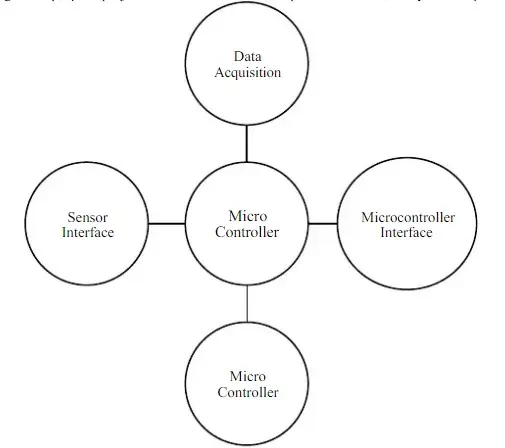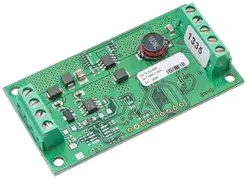Abstract.
A microcontroller, also referred to as an MCU or microcontroller unit, represents an integrated circuit (IC) crafted for specific applications, tailored to execute designated tasks. While commonly employed in products requiring automated control, such as devices, power tools, automobile engine control systems, and computers, microcontrollers extend beyond these realms. Fundamentally, a microcontroller gathers input, processes it, and executes specific actions based on the acquired information.

Typically operating at low speeds ranging from 1 MHz to 200 MHz, microcontrollers necessitate designs geared towards power efficiency, given their embedding within devices often characterized by higher power consumption in other areas. Within an embedded system, the microcontroller serves as a pivotal component, encompassing a processor, memory, and input-output (I/O) peripherals.
Microcontrollers find application across various domains, including embedded controllers or microcontroller units (MCUs) within vehicles, robots, occasional office machinery, medical devices, mobile radio transceivers, vending machines, and household appliances. Notably compact, they are adept at governing functions within portable or personal computing devices, often replacing the need for a complex pre-existing operating system (OS).
1. Introduction
A microcontroller, often abbreviated as MCU for microcontroller unit, represents a singular metal-oxide-semiconductor (MOS) component encapsulating a miniature computer within an integrated circuit (IC) chip. This microcontroller encompasses on-chip memory along with programmable input/output capabilities, housing one or more CPUs equipped with processor cores. Additionally, program memory, typically in the form of Ferroelectric RAM, NOR Flash, or OTP ROM, is commonly integrated into the chip, along with a modest amount of RAM. Unlike microprocessors primarily employed in general-purpose computing systems, microcontrollers are tailored for embedded applications, serving specialized functions in various projects and devices.
In contemporary terminology, a microcontroller refers to a chip. It is notably less intricate compared to a System on a Chip (SoC). While an SoC may include external microcontroller chips as motherboard components, it typically integrates advanced features like a Graphics Processing Unit (GPU) and Wi-Fi interface alongside its internal microcontroller unit circuits. Microcontrollers find extensive use in a variety of applications including materials and devices control, vehicle engine management systems, medical devices, remote controls, industrial machinery, appliances, power tools, toys, and other embedded systems.
In contrast to devices employing separate microprocessors, memory, and input/output components, microcontrollers streamline design by reducing component count and cost. They serve as additional devices capable of executing digital tasks at a lower cost. Moreover, mixed-signal microcontrollers are common, integrating both digital and analog electronics necessary for handling various systems.
In the context of the Internet of Things (IoT), microcontrollers are particularly favored due to their affordability and effectiveness in data collection.
2. Micro Controller
A microcontroller is embedded within a computer to oversee device operations, managing input and output through its central processor. It accomplishes this task by interpreting data received from the devices. Named for its use of minuscule (micrometer-sized) transistors, the microcontroller (μC or uC) is a distinct chip microcomputer originating from the VLSI era, also referred to as an embedded controller. Various microcontroller types available include 4-bit, 8-bit, 64-bit, and 128-bit models, catering to a multitude of applications ranging from robots and home appliances to motor vehicles and various gadgets, each with differing word lengths.
Comprising components such as memory, devices, and primarily a processor, microcontrollers fundamentally necessitate a degree of control, utilized by the device’s user. The QDI Asynchronous 8-bit microcontroller operates on a unique CISC system architecture, featuring an innovative “luxurious” micro-architecture, integrating memory access restriction and two distinct log files (“C”) to streamline compiler formatting, enabling simultaneous data and address calculations.
The microcontroller core is crafted using semi-latency Sensitivity (QDI) common sense, employing a four-phase protocol alongside n-rail encryption. Dubbed MICA, this microcontroller represents a modern cellular-based QDI design within the realm of asynchronous circuits, providing a platform for developing new functionalities. Devices such as controllers with internal microcontroller units are commonplace in the field.
Microcontrollers find widespread use in applications such as material handling systems, vehicle engine management, medical devices, remote controls, industrial machinery, household appliances, power tools, toys, and various embedded systems. Employing a layout distinct from separate microprocessors, memory, and input/output devices, microcontrollers reduce both the quantity and cost of additional components, enabling digital control at a lower cost. Additionally, mixed-signal microcontrollers that integrate analog electronics are not uncommon.
Within the context of the Internet of Things (IoT), microcontrollers serve as an economical and widely utilized data collection method. An important objective in microcontroller programming is achieving a signal output with multiple harmonics between 1000 and 2000 Hz, typically featuring 5-10% higher harmonics at the signal’s beginning and end, contributing to its characteristic mimicry.
3. Data acquisition

Data acquisition involves gathering a wide array of data from real-world physical conditions, which can then be utilized by computers to analyze pattern signals. This process involves converting values, typically achieved through data acquisition systems abbreviated as DAS, DAQ, or DAU, which convert analog waveforms into digital values for processing. Various software applications, including those developed using popular programming languages such as Assembly, Basic, C, C++, and Fortran, are commonly employed to manage data acquisition applications. Additionally, software tools like Java, LabVIEW, Lisp, and Pascal are utilized for this purpose. Open-source software applications are also available, offering comprehensive tools for retrieving data from specific hardware devices, particularly in the medical field where flexible and adaptable software is crucial for complex testing procedures.
Control programs written in assembly language for the ST62 family oversee the entire operation of the system, utilizing two microcontroller interrupts. Timer interruption handles data collection and storage, while PC interruption triggers the data transfer process between the microcontroller and the system. These interruptions are prioritized accordingly, with PC interruption being of higher priority. Human-machine interfaces, such as speech recognition systems, play a vital role in facilitating communication functions, making the authentication process user-friendly and providing relevant information as required. The microcontroller serves as the brain of the provided emergency system, employing power electronics techniques to operate the rest of the system while ensuring minimal performance and reliability objectives in power electronics design.
Designed for the embedded marketplace, microprocessors differ from desktop microprocessors due to certain restrictions. They find applications in various devices such as video game consoles, modems, set-top boxes, digital cameras, mobile phones, printers, access controllers, watches, pens, smart cards, and smart rings. The reference voltage used to generate the PWM control signal is calculated through power electronics, detecting energy changes by comparing current and previous voltage levels. The addition of a PI controller enhances overall system stability and is employed to align the sequence and reference voltage levels.
Flexibility and extension signals to the controller occur naturally, with users selecting hand gestures to indicate preferences. For instance, when greater accuracy is required, precise hand gestures are utilized, while the system’s pose and posture sensors help determine the optimal position. Small enough to enable fast charging times, capacitor C charges to VDD, with high-impedance input capacitors after secondary sensors interfacing with precision and stability. Embedded timers are utilized to start processes involving sensors, motors, switches, keyboards, displays, memory, and other microcontrollers, facilitating seamless interaction with various devices.
4. Microcontroller interface
Developed over numerous years to address the intricate issue of equilibrium, microcontroller designs incorporate various round functions such as cost, quantity, weight, power consumption, reliability, availability, and productivity. In its simplest form, the microcontroller system is perceived as a tool for monitoring processes and controlling operations. Directly interfacing sensors with microcontrollers offers straightforward, compact, and cost-effective design solutions. Essentially, there are two main interface methods: interfaces based on discharge time, utilizing resistors and capacitive sensors, and interfaces based on rate transfer, controlling the microcontroller’s operation sequence, sensor triggering, and measuring the salt time interval (time-digital transition).
Overall, the measured sensor output is semi-digital because it relies on time-based signals. In this article, we introduce Leroy, a microcontroller optimized for low-cost FPGAs. Leroy is an FPGA-based System-on-Chip (SoC) design tailored for software applications, featuring a compact 16-bit processor. The logic cells and chip memories strike a fine balance between reasonable performance and maximum clock frequency, crucial for its role as a utility processor within the SoC, ensuring minimal disruption to the overall design frequency.
These design objectives include implementing a pipeline cache with additional direct addresses in the on-chip memory for local variables, achievable through architecture. The on-chip data memory is shared with both data and general instructions, requiring only memory modules with additional on-chip memory, and the pipeline can execute an instruction in a single clock cycle. For rapid application execution, instructions can be executed using logic cells (LCs), thus minimizing memory dependency.
5. Sensor interface

The sensor interface allows a system to interpret the input signal generated by complex IC sensors, providing a suitable output signal for easy visualization or processing by the host system. Amps sensor interfaces are renowned for their high accuracy, precision, and sensitivity, even in harsh environments. This interface comprises amplification, filtering, signal alignment, and analog-to-digital conversion (ADC). While the ADC may be integrated into your microcontroller, compatibility with ADC input requires a sensor compatible with this feature.
Directly interfacing sensors with microcontrollers offers simple, compact, and cost-effective design solutions. Essentially, two measurement strategies are proposed: (a) based on the charging or discharging time of the RC circuit, applicable to resistance and capacitance sensors, and (b) charge transfer-based interfaces relevant only to capacitor sensors. In both modes, the microcontroller controls the operating sequence, activates the sensor, and scales the time, such as in time-digital conversion, providing data about the measurement.
A snapshot of recorded waveforms from the test system is depicted in Figure 5, showcasing time periods T1 and T2 measured at the oscilloscope and compared to N1 and N2 values from the microcontroller. These values align closely with the theoretical values calculated using SPICE tools, demonstrating the microcontroller’s counter utilization and its variation based on the inverse function. Overall, the measured sensor output exhibits semi-digital characteristics due to its time-based output signal and ratio metric output calculated based on each reading’s output and errors, with worst errors found to be less than 0.3%.
Mechanical construction and high resolution, particularly in capacity sensors rated below 1 pF, are essential for many applications, necessitating precise control over small sensors while maintaining maximum efficiency. However, calibration can be costly and time-consuming, especially in environments with scattered interface electronics power. To mitigate this, it’s preferable to use adjacent interfaces or longer cables connected directly to the sensor(s) for improved performance.
To enhance clarity and reduce noise, the 12-bit counter’s value is increased 16 times in fast mode or 64 times during input tracking in normal mode, ensuring consistent sample collection and accurate deduction of output values. Wireless Sensor Networks (WSNs) offer a versatile solution for wirelessly monitoring real-world data from multiple sensors in one location. With ongoing advancements in wireless communications and the integration of mechanical systems with microelectrodes, WSNs are becoming increasingly capable and adaptable for a wide range of applications.
